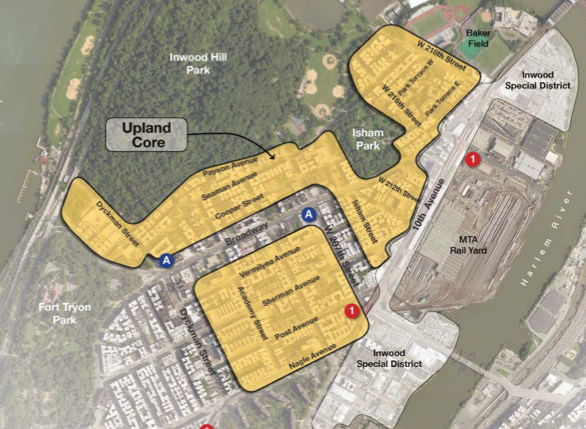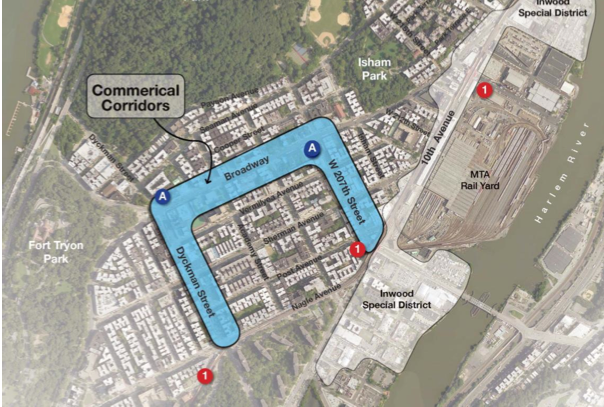
EDC
EDC map depicts the areas where a contextual zoning is now being considered.
The Economic Development Corporation’s rezoning plans for Inwood remain controversial, but last week EDC announced it would answer a demand shared by a variety of stakeholders—a contextual rezoning for several residential parts of the neighborhood.
The Inwood NYC Planning Initiative is one of about a dozen rezonings currently under consideration as part of the mayor’s plan to build or preserve 200,000 units of affordable housing. EDC says its goals for Inwood include converting the industrial land by the waterfront to a thriving mixed-use area, creating a publicly accessible waterfront, supporting local employment and businesses and investing in infrastructure. Local stakeholders have expressed a mix of reactions, from concerns about population growth to a desire to see new housing be deeply affordable and not contribute to the area’s gentrification.
Until recently, the city’s proposal focused on converting the auto and industrial areas on Tenth Avenue and east to medium- to high-density residential and commercial areas. Over the past year, however, community stakeholders have called for a contextual rezoning for the areas west of 10th Avenue.
Contextual rezonings limit density and institute other requirements to ensure that what is allowed to be built is similar to what’s already there. In practice, they help to discourage demolitions and preserve the existing housing stock. They also make it less likely that a developer will succeed in getting a large upzoning in the future.
On March 31, Councilmember Ydanis Rodriguez and Borough President Gale Brewer added their voices to the chorus, writing a letter to the administration that called for a contextual rezoning in addition to a neighborhood-specific preservation plan and “aggressive approach to the creation of affordable housing” through the development of public land and the use of city-subsidies.
The pros and cons of a contextual approach
As reported by Manhattan Times News, on April 27 NYCEDC chief James Patchett wrote in a letter to Rodriguez and Brewer that he was “pleased to pursue a contextual rezoning of Inwood west of 10th Avenue that would compliment our effort to create a holistic framework for development east of 10th Avenue.”
At a community board meeting last week, EDC said it was exploring limiting the density on the blocks west of 10th Avenue and east of Inwood Hill Park, roughly between Dyckman Street to the south and West 218th Street to the north, as well as three blocks between Dyckman Street and Riverside Drive. The exact zoning designations are being explored and have not been announced, but EDC says it will seek to institute street wall requirements and height limits.
In addition, the city is interested in rezoning Dyckman Street, Broadway and West 207 Street (see map below) in order to trigger the city’s mandatory inclusionary housing policy, which would require that 20 to 30 percent of any housing developed there be permanently rent-restricted. That means EDC is considering an upzoning for those corridors—though EDC says it’s also exploring instituting street wall requirements, height limits and ground-floor retail requirements to make sure development fits the character of the neighborhood. The exact zoning designations are yet to be proposed.
It’s important to note that the relationship between contextual rezonings and gentrification is somewhat complex. One the one hand, contextual rezonings deter property owners from demolishing and redeveloping their buildings, decreasing the risk for direct displacement of rent-stabilized tenants and lessening an influx of new market-rate units to the neighborhood. East Village community board members believe that the contextual rezoning they secured in 2008 helped to do just that.
But contextual rezonings do not prevent landlords of existing buildings from harassing tenants or, for market-rate apartments, raising rents, as an area grows more popular. In addition, MIT student Leo Goldberg’s research has shown that during the Bloomberg era, upzonings on major avenues paired with downzonings of residential blocks were often pursued by homeowners interested in protecting their property values and the character of their neighborhoods, and on average were followed by decreases in the number of lower-income, Black and Latino people living in those areas.
Whether a rezoning with mandatory inclusionary housing in Inwood, with its large rent-stabilized housing stock, could present similar risks is unclear.
Announcements greeted with praise, skepticism
At its presentation last week, EDC emphasized that its plan for Inwood consists of far more than a rezoning and includes a new Workforce1 Center in Washington Heights, grants for small businesses and cultural organizations, investments in Highbridge Park, street improvements, the development of a neighborhood-wide drainage plan, a new Legal Services NYC office in Inwood and ramped up tenant outreach and code-enforcement efforts.
The city is also seeking to develop the Inwood library on Broadway with a new facility and 100 percent affordable housing—though the discussion over the project has so far been contentious, with some completely against the redevelopment and others seeking deeper levels of affordability, community land trust ownership and other demands.
In an e-mail to City Limits, Rodriguez said he was greatly pleased with the city’s efforts.
“This will be sure to maintain the low-rise community Inwood is cherished for, while focusing the development of new affordable housing in only select areas,” he wrote. “I’m also glad that the city is taking a renewed focus to preservation of existing affordable housing, including opening a tenant resource office in the area. All in all, through the leveraging of city-owned property to create 100 percent affordable projects, to revitalizing our waterfront, open space and underutilized land, to working to create the jobs of the future for uptown residents, this process will continue to deliver resounding benefits to the neighborhood.”
Charles Corliss, head of the services organization Inwood Community Services, says his organization is “always in favor of anything that preserves the housing of the longstanding residents in this community,” but notes the importance of ensuring that any housing created through an upzoning is actually affordable to the residents of Inwood.
David Thom of the Inwood Owners Coalition, a group representing homeowners, says that residents in Inwood had been calling for a contextual rezoning even before EDC began its neighborhood study.
“We don’t know what the outcome will be yet, but it’s potentially good news that the city is now looking to bring what we’ve long asked for,” he says, though he expressed concern that the city had not included the property owned by Columbia University north of West 218th Street within the contextual rezoning study boundary. In Thom’s view, a contextual rezoning will help protect Inwood’s unique, mid-density character, preventing buildings that stand out “like a sore thumb” on side streets—buildings like the proposed Sherman Plaza site, which Councilman Rodriguez voted down last summer after some residents said it was too tall and others said it was not sufficiently affordable for the neighborhood.
As for the potential upzoning of the main corridors of Broadway, Dyckman and 207th Street, Thom says, “If it’s applied correctly and the overall result is balanced, then there could be an argument to support that kind of endeavor, but the devil is in the details and it really has to be looked at with an overall perspective of balance.”
For organizers with Northern Manhattan is Not For Sale, a coalition of local groups and citywide tenant advocacy organizations, contextual rezonings are appealing because of their potential to deter the construction of “massive luxury towers”‘—including towers with mandatory inclusionary housing, which the group believes do not include enough apartments at rent levels affordable to existing residents. But Graham Ciraulo, an organizer with the coalition, notes that contextual rezonings are not enough to stop displacement: the area needs more resources for tenant organizing and commitments to deeply affordable housing, he says.
The group is also disappointed that EDC has excluded a portion of the area they had proposed be included in a contextual rezoning: about 15 blocks between Dyckman, Broadway and Hillside Avenue on Inwood’s Southside. Ciraulo says that side of the neighborhood also includes many working-class Latino tenants. It also includes the controversial Sherman Plaza site voted down last summer.
Ava Farkas, director of the Metropolitan Council on Housing and a member of the coalition, says that before getting too hopeful, she’s waiting to see the exact contextual zoning designations that the city will propose. And she says that the coalition’s support for a contextual rezoning “in no way means that Northern Manhattan is Not For Sale and Met Council supports the upzoning proposal” for east of 10th Avenue.
The coalition says they could not yet comment on EDC’s proposal to upzone 10th Avenue, Broadway and West 207th Street.
Beyond the contextual rezoning
A contextual rezoning was only one of several demands listed in a September letter to the administration from Northern Manhattan is Not For Sale, the Inwood Owners Coalition, and multiple other neighborhood organizations. The organizations also called for improved public engagement, a significant share of housing for households making less than $25,770 for a family of three, the development of 100 percent affordable housing on public land, efforts to preserve existing affordability, investments in subsurface infrastructure, and limiting the city’s density proposals along Tenth Avenue.
On many of these demands, stakeholders are still waiting for results—especially when it comes to the development of public sites beyond (or instead of) the library.
The September letter did not take a position on the rezoning designations that the city has proposed for the industrial areas east of 10th Avenue—something that not all stakeholders agree on.
“There’s a loud vocal group that don’t want to see anything. There are people who don’t want to see anything that’s market rate. There are people who want market rate but don’t want it to be tall,” Ciraulo explains.
Thom of the Inwood Owners Coalition, for instance, welcomes the development of that area but is concerned with the height and density of the buildings the city has proposed, while Farkas says Northern Manhattan is Not For Sale opposes a rezoning “that’s going to create majority market-rate units,” but has yet to come up with a full position on zoning designations or affordability levels.
As for increasing public engagement, Rodriguez and EDC announced Tuesday that they would co-host a “Tele-Town Hall” to discuss the rezoning via telephone on May 22 at 6 p.m. (details TBD about how to dial in).
But Ciraulo and Farkas say the chosen format is outrageous.
“This is not the way to engage with the constituents. We want to speak directly to our councilman in person and we’re concerned that this is going to discourage people from getting involved in the conversation,” says Ciraulo. “Politicians and political office holders need to look directly at their constituents, whether they’re angry or not. There’s more to communication than just speaking.”
Rodriguez did not respond by press time for a request for comment on the Tele-conference format.
The Department of Housing, Preservation and Development is accepting comments on its Inwood Affordable housing and Library Development Project community visioning report until Friday May 19. Comments can be sent to inwood@hpd.nyc.gov. A final report will be presented Community Board 12’s board meeting on Tuesday May 23,.6:30 pm at the Richard M. Ruzika Theater Campbell Sports Complex, 505 West 218th Street & Broadway.

EDC
EDC map shows the commercial corridors where an upzoning (with some special restrictions) is likely.








2 thoughts on “Details Emerge—and Doubts Remain—About Potential Inwood Rezoning”
A telephone townhall is a very bad idea
A tele-town hall is undemocratic